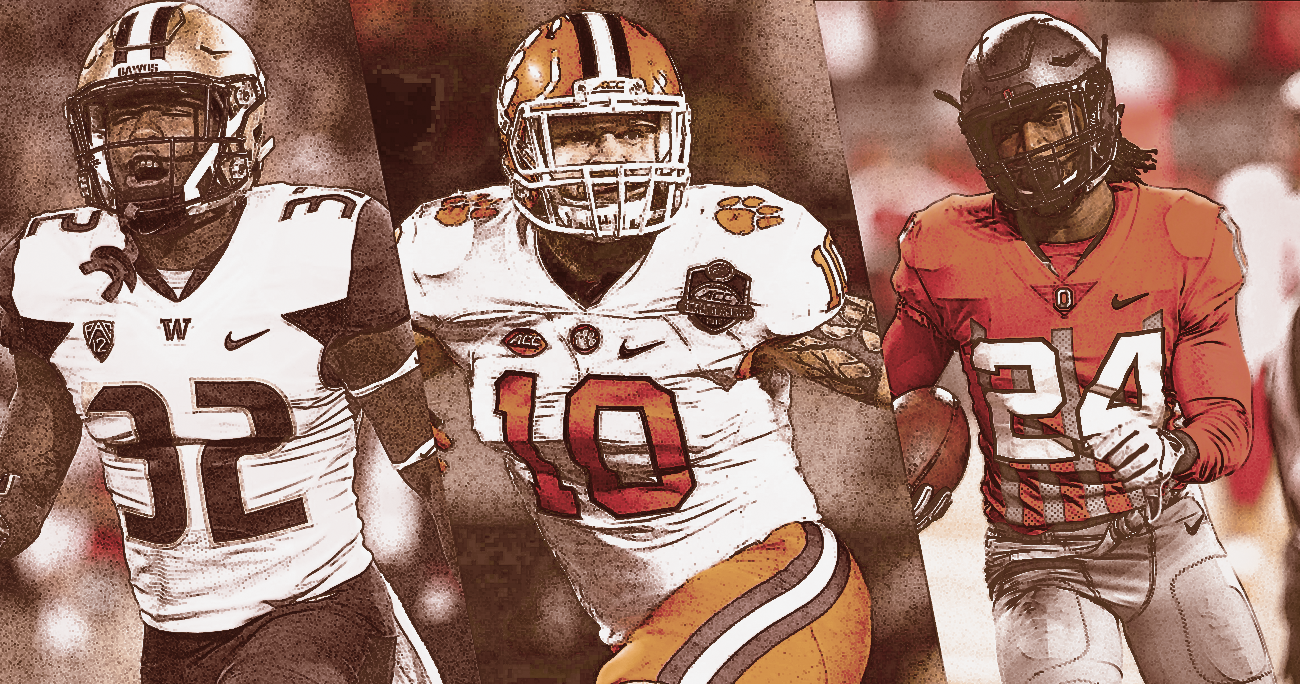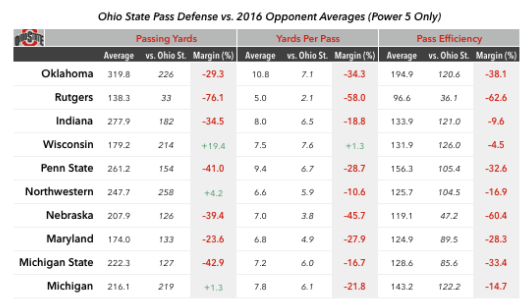Playoff Edge: Each challenger’s defense poses a unique threat to Alabama’s offense. Here’s how
By Matt Hinton
Published:

Playoff Edge: Each challenger’s defense poses a unique threat to Alabama’s offense. Here’s how.
The second half of the season in the SEC played out less like a competition than a coronation, and the smart money on the College Football Playoff is thinking along the same lines: Even before the pairings were announced Vegas had installed Alabama as a huge favorite to repeat as national champs, initially setting the line for Bama’s Peach Bowl date with Washington at 16.5 points — a full touchdown more than the 9.5-point spread in the Tide’s favor ahead of last year’s semifinal beatdown of Michigan State. For a very large segment of viewers, the only drama this time around is where exactly Nick Saban’s most dominant outfit to date will fall among the greatest teams in history.
If he didn’t know better, one might get the impression that the other three teams involved are bit players, content to play out their supporting roles as footnotes in the Tide’s ascent. But of course we do know better: Between them, Washington, Ohio State, and Clemson are all worthy contenders capable of presenting a unique, specific challenge to Bama’s presumed supremacy. Last week, I broke down the potential advantages the Huskies, Buckeyes, and Tigers could exploit on offense against the vaunted Bama D. Today, it’s the defenses’ turn.
Washington: A turnover-forcing machine
Jalen Hurts is the most accomplished true freshman quarterback in recent memory, by a wide margin, and the best QB in the SEC this year by almost as much. But his frequent brilliance has not made him immune to an occasional bout of dumb freshman stuff: Through 13 games, Hurts has committed 14 turnovers (nine interceptions, five lost fumbles), most coming over the second half of the season. And if there’s any defense in America other than Bama’s capable of forcing a young quarterback into a crippling mistake, it’s Washington’s, which forced more takeaways in the regular season than any other FBS team.
True, for a while it was possible to chalk up some of U-Dub’s thievery to the random fortune of fumble luck; the Huskies recovered more loose balls in their first five games (11) than most FBS defenses did all season. (Meanwhile, Washington’s own running backs somehow went the entire year without fumbling once, a combination that helped produce the nation’s best overall turnover margin.)
After midseason, though, the vast majority of their takeaways came via interceptions — a dozen in the final five games — which tend to be much less random and more sustainable than fumble recoveries, especially when they’re the product of such a decorated secondary.
Safety Budda Baker (below) was a consensus All-American; cornerback Sidney Jones joined Baker as a first-team All-Pac-12 pick; and nickel corner Taylor Rapp was named Defensive Freshman of the Year as well as MVP of the Pac-12 title game, where he had two of the team’s three interceptions in a 41-10 romp over Colorado.

All year, healthy turnover margins have helped turn Washington’s significant advantages over opponents into insurmountable ones, leading to huge point spreads: Ten of the Huskies’ 12 wins have come by at least 24 points, and in eight of those 10 wins they enjoyed a turnover margin of +2 or better. If they manage to hit that mark against Bama, whatever other advantages the Tide enjoy might not be enough to overcome it.
Key Player: OLB Psalm Wooching.
The most direct way to force turnovers on a somewhat reliable basis is through the pass rush, and on paper Wooching emerged as Washington’s most disruptive defender off the edge after Joe Mathis was ruled out for the season with a bum foot. But that distinction rests largely on a single game, the Huskies’ breakthrough, 44-6 win over Stanford back in late September, to which Wooching contributed three sacks and a forced fumble and was subsequently named national Defensive Player of the Week by the Walter Camp Foundation.
He’s been much quieter since, generating just 1.5 sacks in the final eight games. Aside from a dominant night against Arizona State, Washington has struggled to get to the passer as a team in Mathis’ absence, a trend it will have to break if it expects to benefit from any generosity from Hurts.
Ohio State: A pick-six machine
The Buckeyes also fared well in the takeaway department, not only matching Washington’s 19 interceptions but taking seven of them back for touchdowns. The defense scored in blowout wins over Oklahoma and Nebraska (twice), and Malik Hooker’s pick-six against Michigan is on the short list of the most consequential plays of the year.
But what really stands out about Ohio State’s pass defense is how good it was, week-in, week-out, against every opponent on the schedule. The Buckeyes only returned one starter on the back end from 2015, and still led the nation in pass efficiency D by holding nearly every opposing offense they faced below their season averages across the board:

The most impressive line on that chart is the first one — barring a disaster in the Sugar Bowl, Oklahoma quarterback Baker Mayfield is all but assured of breaking Russell Wilson’s single-season record for pass efficiency, and his rating in OU’s loss to Ohio State in September (120.6) remains his only sub-170.0 rating of the entire season. (The national average for pass efficiency is roughly 135.0; Mayfield’s numbers in every other game are truly absurd.) No one else hit their average rating, and following an overtime scare at Wisconsin at midseason no one came all that close.
Hurts only faced one defense that can plausibly match up with the Buckeyes statistically and athletically — LSU’s — and not coincidentally posted his worst passing game of the his young career against the Tigers in a 10-0 slugfest. If OSU can depress his output to the same extent it has everyone else’s, Bama’s margin for error on defense suddenly plummets.
Key Player: S Malik Hooker.
Outside of deep-diving Buckeye fan sites, Hooker began the season with virtually zero name recognition — by Ohio State standards, he wasn’t even a high-profile recruit — which is one of the prerequisites for a defensive player to generate any real buzz even on a team with as much national exposure as OSU; it’s the only reason Hooker isn’t on the verge of becoming a household name.
With more preseason love, his three pick-six touchdowns (on a B1G-best six interceptions overall) might have gotten Hooker into the Heisman conversation along with, or instead of, Michigan’s Jabrill Peppers. That won’t be a problem next year, when Hooker has already said he’s “100 percent coming back” to Columbus with everyone’s full attention … that is, if he actually follows through on his promise. A star turn in a playoff game could alter the equation.
Clemson: A line-stuffing machine
Alabama’s defensive front under Saban is perennially the best in the country, and this year’s edition might be the best yet against run and pass alike. But the emerging d-line pipeline at Clemson is a marvel in its own right: In four years under defensive coordinator Brent Venables, the Tigers have ranked at or near the top nationally in tackles for loss each year despite a steady exodus of top talent – they’ve had to replace five draft picks from the d-line over the past two years alone, with no discernible drop-off in athleticism or production.
The 2015 front featured four new starters top open the season, yet still led the nation in TFLs (again), sacked Jacob Coker five times in the championship game, and ultimately sent three of the four rookie starters on to the next level. The 2016 front is a different group than the Tide had to contend with last year, but so far it’s been every bit as good.
In fact, man for man this year’s front four is arguably the most talented of the Swinney/Venables era, which is saying something. Inside, the Tigers are anchored by a pair of blue-chip tackles, senior Carlos Watkins and true freshman Dexter Lawrence, who have managed to lead the pass rush with a combined 15 sacks from the interior.
Outside, they boast another five-star talent, sophomore Christian Wilkins, who was credited with a dozen TFLs and picked up a couple of All-America nods after converting from tackle to end. Along with the other starting end, underrated sophomore Clellin Ferrell, all four starters have eventual first-round potential; according to the site NFL Draft Scout, the underclassmen (Wilkins, Lawrence, and Ferrell) are all projected as the No. 1 prospects in their respective classes at their positions, and Watkins comes in at No. 2 among senior DTs.
They’ve looked the part. As a team, Clemson has multiple sacks in 11 consecutive games; in the biggest of those games, the Tigers recorded four sacks against Auburn, five against Louisville, six against Florida State, and four against Virginia Tech in the ACC Championship.
They rank fourth in Adjusted Sack Rate, just ahead of Alabama’s sack-happy front at no. 8, and well in front of Bama’s offensive sack rate, where the Tide come in at no. 43. That’s as clear an advantage as any of the other three playoff teams has against Bama in any single aspect, and based on Clemson’s success getting to the quarterback in last year’s game Venables is more than capable of exploiting it.
Key Player: LB Ben Boulware.
He’s not as touted as the down linemen in front of him, but Boulware is the team’s leading tackler, a first-team All-ACC pick, and a quietly effective blitzer with eight sacks over the past two years.
Back in October, he was also the key cog in Clemson’s game plan against Louisville, spying, tracking down, and generally harassing Lamar Jackson en route to the Tigers’ biggest win of the year. Boulware recorded career highs in that game for total tackles (18) and TFLs (3), potentially previewing how Venables might deploy him against another mobile quarterback like Hurts.
If the front four are able to flush Hurts from the pocket on a regular basis, having a reliable, veteran tackler in position to finish him off could be a critical asset.
Photo credit: USA TODAY SPORTS
Matt Hinton, author of 'Monday Down South' and our resident QB guru, has previously written for Dr. Saturday, CBS and Grantland.
You might also like...







